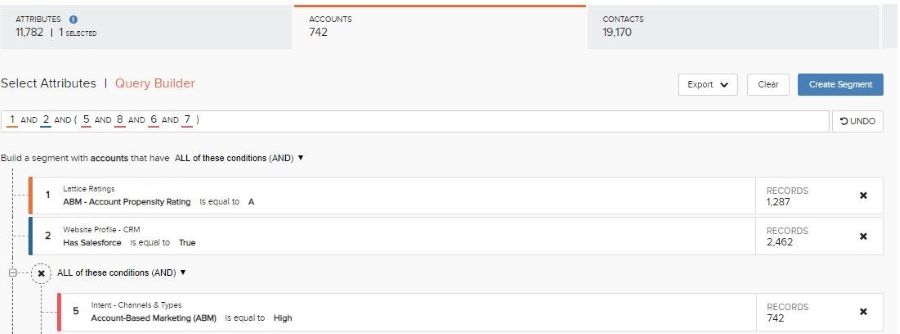How our LinkedIn Ads Work in Conjunction with Sales Outreach
The following article was originally written by Lattice Engines which was acquired by Dun & Bradstreet in 2019.
With customers using so many digital channels to communicate today, omnichannel engagement is incredibly important to running a successful account-based marketing (ABM) program.
But omnichannel engagement only works well when the experience is relevant and consistent for customers across channels. To that end, at Dun & Bradstreet, we’re using a combination of different channels in order to engage with our target accounts: social, email, events, display ads, direct mail, SDR/sales, etc.

Figure 1: Example of ABM campaign flow
We ensure that our paid social programs are as effective as possible by aligning our LinkedIn advertisements directly with the approach and messaging that our sales development representatives (SDRs) are using with their prospects. This has enabled us to ensure that LinkedIn ads are being sent to the right people, at the right time, with the right message.
In this post, you’re going to get an inside look at how our LinkedIn ad program works in conjunction with sales outreach. You’ll see exactly how LinkedIn has become an essential channel for generating new leads. If you are a digital marketer trying to understand how to get better results from your ABM program, these insights may help.
Align Your Target Audiences and Zero in on the Right Segment
The first step to running an effective LinkedIn strategy in conjunction with sales is to ensure that your target audiences are completely aligned. So you will need to start by identifying which accounts the sales team is targeting heavily within your total addressable market.
We used D&B Lattice to identify our ideal target accounts and prioritize them for outreach.
One of the objectives of our LinkedIn program is to generate awareness in our target accounts and provide air cover while SDRs call into those accounts. In this example, we filtered out target accounts with active opportunities and got a list of roughly 740+ accounts that we were looking to engage with.

Figure 2: Example of List Segmentation
Now you may be thinking that 740+ accounts is quite small for a LinkedIn campaign. However, the goal of these campaigns is to strategically and systematically improve sales results — not to “spray and pray” to a large, possibly unsuitable audience. We are providing additional support for our SDRs who are already reaching these accounts through email, LinkedIn messaging, and phone calls.
To that end, now it’s time to take that narrow list and narrow it down even further to get even more targeted in your LinkedIn ad strategy!
Here’s how we did it: After syncing the audience into LinkedIn, we narrowed it down further based on title and persona.
Message Match: Design Your LinkedIn Ad With Similar Messaging to Sales
With a list of prospects to target on LinkedIn, it’s time to design the ad. But don’t start putting copy and images together just yet! To get the best results, your LinkedIn ad messaging should match the messaging the sales team is using.
This consistency helps build trust with the target audience, and it’s absolutely critical to the success with this strategy.
Before you start creating your ads, you need an understanding of the type of messaging and content that resonates with your prospects.
We meet with our sales team to understand what type of messaging they are using as well as content that performs well for them. Then we use that insight to guide our LinkedIn ads.

Figure 3: Example of LinkedIn Ad

Figure 4: Example of Landing Page
Results: The Top-Line Benefits of Aligning Your LinkedIn Ads With Sales Efforts
Running our LinkedIn ads in conjunction with SDR efforts has proven incredibly valuable for generating new leads and creating meetings for the team.
An additional result we were pleasantly surprised by is that the SDR team has been generating more engagements (meetings) as a whole because of these ads. The prospects they are reaching out to are seeing digital ads with similar messaging, which reinforces the SDRs’ communications and encourages engagement all the way through the sales process.
Now, instead of wasting ad budget on accounts that are low-fit and will never buy, our digital ads are only being sent to accounts that our SDR team is actively targeting. The end result is that we’re generating higher engagement through both channels.

Figure 5: LinkedIn Campaign Performance
With D&B Lattice’s always-on audiences feature, our audiences update in real-time as individual target accounts progress down the buyer journey. So if a target account suddenly becomes “in-market” (because they’re searching for “ABM Solutions” or “Customer Data Platforms” on third-party websites), our LinkedIn campaign will automatically start targeting them with the most relevant content.
